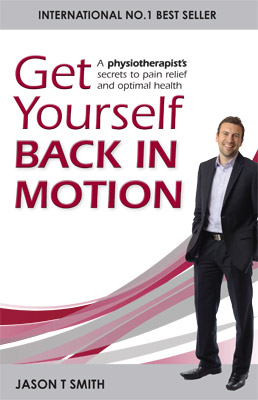Get Yourself Back In Motion

Get Yourself Back In Motion
Physiotherapy is set to take the world stage as a key player shaping our overall health and wellness as Australia's leading Physiotherapist Jason Smith launches his life-changing book Get Yourself Back In Motion.
This is the first book of its kind empowering individuals to self-manage pain and optimise their health through never before revealed physiotherapy secrets and tips.
The book debunks common myths surrounding pain and promotes a preventative and proactive approach to achieving lifelong physical health, unlike many traditional physios.
Jason Smith, Founder of Back In Motion, Australia's fastest growing Health Group, reveals secrets of his highly successful Results4Life® philosophy, which has already helped thousands take control of their health.
Jason says, "Results4Life empowers individuals to partner with their Physiotherapist to achieve optimal lifelong physical health, rather than resorting to the quick fix mentality"
"This method gives you the tools to help improve sleep, fitness habits, nutrition and pain management to live with more energy and mobility and perform better in all facets of your life"
Over 80% of Australians suffer from lower back pain at some stage in their life, yet according to Jason "pain" is simply not an acceptable diagnosis. The cause of pain must be deeply understood for practitioners to help patients achieve true health.
Jason says "Many people view their Physiotherapist as a glorified masseuse and only seek our help when they are already injured or in pain. However, our philosophy encourages people to visit us regularly to improve and strengthen their bodies, so that they do not end up in pain".
Smith says the Back In Motion network has refined the approach to Physiotherapy with preventative and proactive therapies which minimise the onset of aggravations and pain.
"Traditionally therapists have often managed pain 'reactively' - which has only short term gain for the patient," he said.
"Following the Results4Life philosophy, Back In Motion therapists design a comprehensive tailored program that enables the client to self-manage their problem while helping to prevent the reoccurrence by resolving the underlying cause of the pain.
"We see our role as Physiotherapists to be a health facilitator and partner with patients to help them achieve overall wellness for life, rather than just provide symptomatic treatments that provide a temporary solution".
Jason Smith's Top Six Tips for Good Physical Health
Moving well is at the core of true positive health. Move more intentionally, every day. Avoid a sedentary life. Be physical.
It is not normal to be in pain or carry injuries. Don't ignore pain, niggles, aches or stiffness. Get your body properly assessed and overcome the pain for life. Early intervention is key.
Pay attention to your posture - static and dynamic. Lifelong physical health depends on daily habits that encourage correct posture and core stability.
You truly are what you eat; your food is your medicine. Limit processed foods and pay attention to volume and content.
Health is a lifetime investment. True health comes with daily management. Take care of your body every day through movement, lifestyle & nutrition.
Get Yourself Back In Motion is available at Back In Motion Health Group practices, major book retailers and online bookstores RRP $29.95.
To find your nearest stockist visit www.GetYourselfBackInMotion.com or call 1300 MY HEALTH for your nearest Back In Motion Health Group practice.
Back In Motion Health Group is Australia's leading provider of Physiotherapy and related services with a corporate commitment to excellence and delivering results focused, sustainable outcomes for clients, the Back In Motion team pride themselves on their innovative philosophy of Results4Life, which empowers optimal lifelong physical health. The concept of having a Physiotherapist on the health/wellness journey throughout one's life is key to the Back in Motion philosophy. Physiotherapy should not be a quick pain fix, but a journey of partnership in health.
Ranked 13th on the BRW Fast Franchises 2012 list, the group has just celebrated its 5th year on the esteemed list. The Back In Motion Health Group is one of only four companies in the health and community services sector to be awarded this accolade and the only to have achieved this success five years running. Based in Mulgrave, Melbourne, but with over 35 franchises and 60 locations across four states (VIC, QLD, SA, TAS), the group led by founder, physiotherapist and National Group Director Jason Smith, has enjoyed sustained growth since its inception in 1999.
www.backinmotion.com.au
Get Yourself Back In Motion
Back In Motion Health Group
Author: Jason Smith
Price: $34.95
Interview with Jason Smith
Question: Why did you decide to write Get Yourself Back In Motion?
For years my patients have asked for my information in a written form and I believed it was about time that I wrote the book so that patients could be self-empowered in these approaches and that way they don't have a dependency on doctor, physiotherapist or physician because they can manage their own health.
Question: What is the difference between Life-Fit and Gym-Fit?
Jason Smith: Life-Fit is a phrase that I have coined which takes the concept of fitness and strips it of all the connotations that it imposes including the expectation of having to be very competitive, extreme and sporty and actually just empowers with all of the important aspects of 'lifestyle fitness'. 'Lifestyle fitness' is assessable, attainable and most importantly sustainable.
Life-Fit is unique to every person, it's not a one size fits all but it really comes about by assessing an individual's energy requirements in a day, their occupation, interests, hobbies and the things that they want to do in a given 24 hour period. Then I design an individually tailored health and exercise program that enables them to not just endure the day but to get to the end of it with some energy in reserve.
When I talk about health I'm not just talking about good posture, or recovering from an injury or just being pain free. My definition of health is performing at your best; it's about being optimally well and so often I think people are conceding for a life of compromise when they don't look after their health.
Question: Why is posture the key to overall health?
Jason Smith: I regard posture as one of the top seven keys to overall health because physically posture is the scaffolding or the infrastructure that the body is made up of. One of my key messages is to try and get the population to move better and for longer and to do this you need good equipment and your body is your equipment (scaffolding). If people can manage, control and self-assess their posture they will be able to prevent most of the injuries that generally occur in people other than traumatic injuries. Most of the strains, sprains and overuse injuries have a postural base to them and we've had incredible results from clients when they learn how to manage their posture.
The setup of workstations and desks will certainly aid or discourage the right postural approaches along with the way we sit in the car, how high the kitchen bench is and your posture when you're on the couch watching television or riding a bike. Posture permeates every movement and activity of our world.
In this book I want people to not only think of posture as standing up straight with a ruler down your back but as the position your body takes during an activity and there is a right and wrong way to do everything.
Question: How can we setup our workstations to increase health and wellbeing?
Jason Smith: Setting up workstations is deceptively difficult and I don't think it's easy at all! When setting up workstations there is not one way that suits all as everybody is a different shape, size and have different tasks and durations at that workstation. The design and setup has to be tailored to each individual. I often spend up to an hour, with clients, setting up their workstation to ensure the ergonomics and postures are correct. I have never walked into a work station that has been setup correctly!
In terms of simple tips:
The most important thing to start with is the right chair as the chair sets the platform for all of the postures working height and surfaces. A chair that has a lot of adjustments is important, those adjustments are the height, tilt in the seat, the back and arm rests and even the swivel. When you do have the chair adjusted to suit you, it needs to be guarded with your life; (laughs) don't interchange chairs, even in my home office my wife and I have a chair each. Once you get the chair right, you don't want to have to spend more time getting it right again as most people will just think "I'll put up with it" and then you expose yourself to risks.
The way to fit your chair to you properly is to make sure the actual seat height allows your knees to bend comfortably at 90 degrees and if your feet can't fully touch the floor, from heel to toe, then you need to use a foot rest. The chair should allow you to just lift your thighs off the chair seat, so there is a little bit of space between the back of the thigh and the chair itself which means there is not a lot of continuous load going through the legs. Make sure the chairs back rest is slightly reclined by 90 - 100 degrees on the vertical as that allows you to fully distribute the upper body weight through the chair. There should be a lumber support in the chair and if the chair doesn't have one then that can be replicated with either an external lumber roll or a cushion that can be placed in the lower back.
The monitor, on the desk surface, should be set so the top height of the monitor is equivalent with your eye level. A lot of people look up or down at their monitor which creates all sorts of neck postures. The monitor should be one outstretched arm's length in front (no closer and no further). Very importantly people should be taking visual breaks; I use the rule '20, 20, 20' which means 20 minutes of screen time and then you look at a distance of 20 metres for about 20 seconds and then you can go back to working.
Your keyboard, mouse and telephone should be within a comfortable reach because you shouldn't have to lean, strain or move awkwardly to access them. If you do lean or strain over the course of an eight hour working day it will create repetitive stress and cause posture abnormalities that will eventually present as pain and dysfunction.
Question: What tips do you have to get a good night's sleep?
Jason Smith: Sleep is one of the most underrated aspects of true health and I have probably learnt this the hard way as I have been a sleep minimalists, meaning I slept for less than five hours a night. In my own research and experience I have learnt that sleep is one of the critical elements.
To get a good night's rest my tips when addressing an adult audience are:
You need to get between 7 and a half to 9 hours sleep a night and as many of those hours before midnight, as possible. Sleeping from midnight to 9am isn't actually as good as sleeping four hours before midnight and that is to do with the way the hormones get recharged in the adrenal glands.
It's very important that people actually learn to assess their own signs of sleep deprivation which can present in many different ways, the obvious signs are moodiness, fatigue, lack of concentration, dizziness and more physically people can even feel nauseous and delay their healing when they're sleep deprived. One of the most important tips when managing sleep is to be self-aware of the signs of sleep deprivation.
Sleep loss is accumulative and is like building a debt at the bank because if you miss an hour tonight and only have eight hours sleep the next night you are actually persisting in sleep deficit. If you miss a couple of hours one night, over the next week you need to try to slowly recover the lost hours.
A good pillow is critical and that speaks to the physical posture of the body and if you don't have a good pillow you may experience different forms of discomfort throughout the night and subconsciously your body will be disrupted and may wake. The same can be said about a mattress which is why getting a very good mattress is important as well, the book contains a list of good attributes a mattress needs to have.
Interview by Brooke Hunter
MORE



